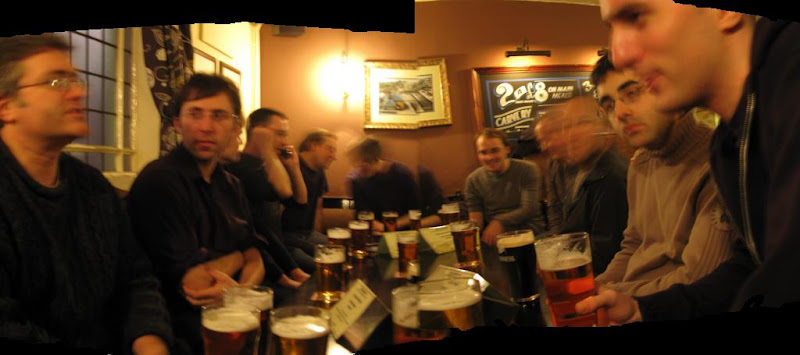 After visiting the National Gallery I drove into the heart of Edinburgh and managed to find a couple of very nice used and rare bookshops. Armchair books is at 72-74 West Port and occupies two narrow shops that are adjacent to one another. The owner is somewhat cranky as evidenced by a sign on the door saying something to the effect of: "The government is trying to close me down and so, at any moment, this shop may revert to a private premises in which case you are my guest." The owner was there and I asked him about the sign, and was told about the governments efforts to close him down because he is deemed a fire hazard, among other things. In any case, I asked him if there were any other shops nearby and he said the only one he could compare to his own was in Paris, Shakespeare & Co.. I've been to Shakespeare & Co. and I think the comparison may be a bit of a stretch. But actually, I may like Armchair books better, it is dustier, has a broader selection and is a bit less "Literary". So I pressed him a bit more and then he did point me to McNaughtan's bookshop about a mile away. It was getting late and so I decided to visit McNaughtan's on another visit. As I walked towards the car park, and less than a block from his shop I hit another very good second hand and antiquarian bookstore, almost as good as his own I'd say. This one is Edinburgh Port Books. And there was another smaller one half a block further on. Now that I'm back in St Andrews and have access to the web I see that there was another shop (Andrew Pringle) less than a block downhill from Armchair that he neglected to mention as well. In any case, I bought two books at Armchair, one an inexpensive copy of Negly Farson's Going Fishing first published in 1942 and which is illustrated with woodcuts by C.F. Tunnicliffe.
After visiting the National Gallery I drove into the heart of Edinburgh and managed to find a couple of very nice used and rare bookshops. Armchair books is at 72-74 West Port and occupies two narrow shops that are adjacent to one another. The owner is somewhat cranky as evidenced by a sign on the door saying something to the effect of: "The government is trying to close me down and so, at any moment, this shop may revert to a private premises in which case you are my guest." The owner was there and I asked him about the sign, and was told about the governments efforts to close him down because he is deemed a fire hazard, among other things. In any case, I asked him if there were any other shops nearby and he said the only one he could compare to his own was in Paris, Shakespeare & Co.. I've been to Shakespeare & Co. and I think the comparison may be a bit of a stretch. But actually, I may like Armchair books better, it is dustier, has a broader selection and is a bit less "Literary". So I pressed him a bit more and then he did point me to McNaughtan's bookshop about a mile away. It was getting late and so I decided to visit McNaughtan's on another visit. As I walked towards the car park, and less than a block from his shop I hit another very good second hand and antiquarian bookstore, almost as good as his own I'd say. This one is Edinburgh Port Books. And there was another smaller one half a block further on. Now that I'm back in St Andrews and have access to the web I see that there was another shop (Andrew Pringle) less than a block downhill from Armchair that he neglected to mention as well. In any case, I bought two books at Armchair, one an inexpensive copy of Negly Farson's Going Fishing first published in 1942 and which is illustrated with woodcuts by C.F. Tunnicliffe. 
This image alone is worth the cost of the book. I also purchased a copy of Salmon Fishing by "Tavener & others" first published in 1935 and which is volume X in The Lonsdale Library of Sports, Games & Pastimes published by Seeley Service & Co. Limited in London.
As for book shops ...There is another Shakespeare & Co. in Berkeley CA as well. It's not particularly noteworthy. Last time I was there, I asked if they were affiliated with the Paris store and was told that they were. This is contradicted by the information on the Paris store's website. With Moe's books and Black Oak Books also in Berkeley, it must be the best used book town in the world. I think, for scholarly titles Moe's and Black Oak would be hard to beat. Black Oak has the most extensive collection of math and logic books anywhere. (No, I haven't been to Powell's in Portland.) The Strand in NYC is wonderful as well although I seem to recall having left a bit disappointed the last time I was there. In 1988 or so I bought used technical books in London at Skoob books near Russell Square. I can still remember the name because "Skoob" is "books" spelled backwards and so the name is a palindrome. I just googled them to see if they're still around and in fact, they advertise themselves as The best secondhand bookshop in London. When I was last there, they had an very good collection of logic and theoretical computer science titles and I am looking forward to getting there again when Penelope comes in March and we visit London together to look at art.







